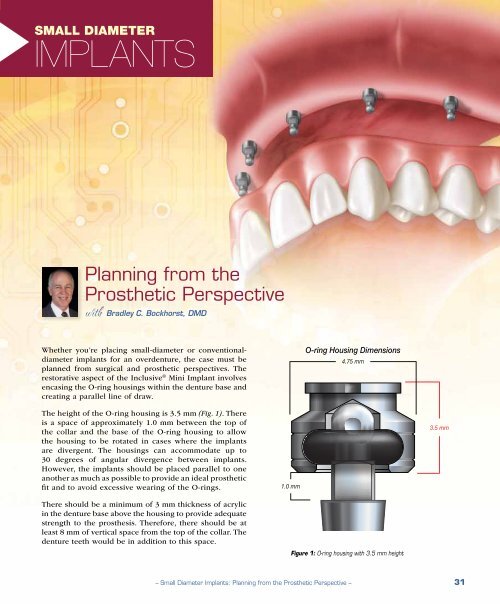PDF Download - Glidewell Dental Labs
PDF Download - Glidewell Dental Labs
PDF Download - Glidewell Dental Labs
You also want an ePaper? Increase the reach of your titles
YUMPU automatically turns print PDFs into web optimized ePapers that Google loves.
SMALL DIAMETER<br />
implants<br />
Planning from the<br />
Prosthetic Perspective<br />
with Bradley C. Bockhorst, DMD<br />
Whether you’re placing small-diameter or conventionaldiameter<br />
implants for an overdenture, the case must be<br />
planned from surgical and prosthetic perspectives. The<br />
restorative aspect of the Inclusive ® Mini Implant involves<br />
encasing the O-ring housings within the denture base and<br />
creating a parallel line of draw.<br />
O-ring Housing Dimensions<br />
4.75 mm<br />
The height of the O-ring housing is 3.5 mm (Fig. 1). There<br />
is a space of approximately 1.0 mm between the top of<br />
the collar and the base of the O-ring housing to allow<br />
the housing to be rotated in cases where the implants<br />
are divergent. The housings can accommodate up to<br />
30 degrees of angular divergence between implants.<br />
However, the implants should be placed parallel to one<br />
another as much as possible to provide an ideal prosthetic<br />
fit and to avoid excessive wearing of the O-rings.<br />
There should be a minimum of 3 mm thickness of acrylic<br />
in the denture base above the housing to provide adequate<br />
strength to the prosthesis. Therefore, there should be at<br />
least 8 mm of vertical space from the top of the collar. The<br />
denture teeth would be in addition to this space.<br />
1.0 mm<br />
Figure 1: O-ring housing with 3.5 mm height<br />
3.5 mm<br />
– Small Diameter Implants: Planning from the Prosthetic Perspective – 31

















